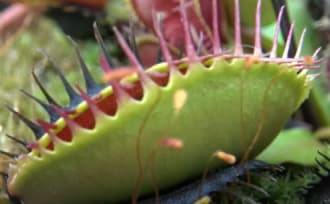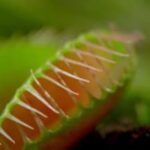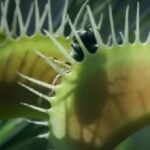As an Amazon Associate, this site earns commissions from qualifying purchases. For more details, click here.
Venus flytraps (Dionaea muscipula) are fascinating carnivorous plants known for their unique trapping mechanism and ability to catch small insects. While they thrive in specific conditions, such as acidic, nutrient-poor soil and ample sunlight, they can also make interesting companions for other plants. In this article, we’ll explore some herbs that can be grown alongside Venus flytraps, creating a diverse and visually appealing mini-ecosystem.
Key Takeaways:
- Create Harmony: Growing herbs alongside Venus flytraps can create a harmonious and visually appealing garden space.
- Similar Requirements: Select herbs with similar growing conditions, such as well-drained soil and ample sunlight, to thrive alongside Venus flytraps.
- Diverse Benefits: Integrating herbs like mint, thyme, and lavender with Venus flytraps adds diversity, aroma, and potential culinary and medicinal benefits to your garden.
Mint
Mint is a versatile herb known for its aromatic leaves and rapid growth. It prefers moist, well-drained soil and partial shade, making it a suitable companion for Venus flytraps, as both plants enjoy similar growing conditions.
Mint’s spreading habit can help cover bare soil around the Venus flytrap, providing a lush backdrop. There are many varieties of mint to choose from, including spearmint, peppermint, and chocolate mint, each with its own unique flavor profile.
Thyme
Thyme is a low-growing herb with small, aromatic leaves that add flavor to a variety of dishes. It thrives in well-drained soil and full sun, making it compatible with Venus flytraps’ requirements.
This herb’s delicate appearance contrasts nicely with the Venus flytrap’s carnivorous nature, creating an interesting visual juxtaposition. Additionally, thyme is known for its ability to attract pollinators, such as bees and butterflies, which can benefit the overall health of the garden ecosystem.
Lavender
Lavender is prized for its fragrant flowers and soothing properties. It prefers well-drained soil and plenty of sunlight, making it a suitable companion for Venus flytraps.
Lavender’s upright growth habit and colorful blooms add height and visual interest to the planting area, complementing the Venus flytrap’s low-growing form. In addition to its ornamental value, lavender is also known for its repellent properties, which can help deter pests from damaging nearby plants.
Parsley
Parsley is a biennial herb commonly used as a garnish or seasoning. It thrives in rich, well-drained soil and partial shade, making it compatible with Venus flytraps’ growing conditions.
Parsley’s lush foliage and upright growth habit provide a striking contrast to the Venus flytrap’s carnivorous leaves, creating a visually appealing display. Furthermore, parsley is rich in vitamins and minerals, making it a nutritious addition to your culinary creations.
Chives
Chives are perennial herbs known for their mild onion flavor and edible leaves. They prefer well-drained soil and full sun to partial shade, making them suitable companions for Venus flytraps.
Chives’ slender, grass-like foliage adds texture to the planting area, complementing the Venus flytrap’s distinctive appearance. These herbs are known for their pest-repelling properties, which can help protect nearby plants from insect damage.
Rosemary
Rosemary is an evergreen herb with fragrant, needle-like leaves. It thrives in well-drained soil and full sun, making it compatible with Venus flytraps’ requirements.
Its upright growth habit and aromatic foliage add height and texture to the planting area, enhancing the overall aesthetic. In addition to its culinary uses, rosemary has long been valued for its medicinal properties, including its ability to improve digestion and boost cognitive function.
Growing Herbs Successfully with Venus Flytraps
Integrating herbs with Venus flytraps can create a dynamic and visually appealing garden setting. However, to ensure successful growth for both plants, it’s essential to consider certain factors. Here are some valuable tips for cultivating herbs alongside Venus flytraps effectively.
Select herbs that thrive in similar growing conditions as Venus flytraps. Look for plants that prefer well-drained soil, partial to full sunlight, and moderate moisture levels. Consider herbs like mint, thyme, lavender, parsley, chives, and rosemary, as they share similar preferences with Venus flytraps.
Space Requirements
Recognize the space requirements of both Venus flytraps and the chosen herbs. Venus flytraps typically require a minimum spacing of a few inches between plants to prevent overcrowding and ensure adequate airflow.
Choose herbs that won’t overshadow or compete with Venus flytraps for sunlight, ensuring each plant receives the necessary light to thrive.
Maintain Soil pH
Venus flytraps thrive in acidic soil with a pH level between 4.5 and 5.5. Ensure the selected herbs also tolerate acidic conditions or adjust the soil pH accordingly.
Test the soil pH periodically and amend it as needed using organic materials like pine needles or peat moss to maintain an optimal growing environment for both Venus flytraps and herbs.
Provide Proper Drainage
Herbs and Venus flytraps both prefer well-drained soil to prevent waterlogging, which can lead to root rot and other issues.
Use containers with drainage holes or amend garden beds with organic matter like compost to improve soil structure and drainage. Ensure excess water can freely drain away from the roots of both herbs and Venus flytraps.
Water Carefully
Water herbs and Venus flytraps judiciously, avoiding both drought stress and waterlogged conditions.
Water herbs when the soil feels dry to the touch, but be mindful not to overwater. Allow the soil to partially dry out between watering sessions to prevent root rot. Use rainwater or distilled water for Venus flytraps to avoid the harmful effects of minerals found in tap water.
Monitor and Adjust Light Levels
Place herbs and Venus flytraps in a location that receives adequate sunlight, typically at least six hours of direct sunlight per day.
Monitor the light levels and adjust the placement of plants as needed to ensure they receive the optimal amount of sunlight without being exposed to excessive heat or intense light, which can cause sunburn.

Regular Maintenance
Remove any dead or yellowing leaves from both herbs and Venus flytraps to maintain plant health and appearance. Keep an eye out for pests and diseases, treating any issues promptly to prevent them from spreading to neighboring plants.
Fertilize herbs sparingly, as Venus flytraps derive their nutrients from catching insects and may be sensitive to chemical fertilizers. Consider using organic fertilizers or compost to provide nutrients to both plants.
Common Pests on Venus Flytraps and Herbs
Here are e some of the most prevalent pests that may affect Venus flytraps and herbs, along with strategies for effective pest management.
Venus Flytrap Pests
Aphids:
- Aphids are small, soft-bodied insects that feed on the sap of plants, including Venus flytraps.
- They can cause distorted growth, yellowing leaves, and the development of sooty mold.
- To control aphids, rinse affected plants with a strong stream of water or use insecticidal soap. Predatory insects like ladybugs can also help keep aphid populations in check.
Spider Mites:
- Spider mites are tiny arachnids that feed on plant sap, often leaving behind fine webbing on leaves.
- Infestations can cause stippling, yellowing, and premature leaf drop.
- Control spider mites by regularly spraying plants with water to dislodge them, applying neem oil or insecticidal soap, or introducing predatory mites.
Fungus Gnats:
- Fungus gnats are small, black flies that lay their eggs in moist soil. The larvae feed on organic matter and plant roots, potentially causing damage. Watch out for these if you grow Venus flytraps in a water garden.
- To control fungus gnats, allow the soil to dry out between waterings, use sticky traps to catch adult flies, and apply beneficial nematodes to target larvae.
Common Pests in Herbs
Whiteflies
- Whiteflies are tiny, moth-like insects that feed on the underside of leaves, often in large groups.
- They can cause yellowing, wilting, and stunted growth, as well as the transmission of plant viruses.
- Control whiteflies with insecticidal soap, neem oil, or reflective mulches. Encourage natural predators like ladybugs and lacewings to help keep populations in check.
Thrips
- Thrips are small, slender insects that feed on plant sap, causing stippling, silvering, and distorted growth.
- They can transmit diseases and viruses, further compromising plant health.
- Control thrips with insecticidal soap, neem oil, or predatory insects like minute pirate bugs and predatory mites.
Powdery Mildew
- Powdery mildew is a fungal disease that appears as a white, powdery growth on plant leaves and stems.
- It thrives in warm, humid conditions and can quickly spread to neighboring plants.
- Control powdery mildew by improving air circulation, avoiding overhead watering, and applying fungicidal sprays or sulfur-based products.
Preventive Measures
- Maintain Plant Health: Healthy plants are better able to resist pest infestations. Provide proper care, including adequate water, sunlight, and nutrients, to keep Venus flytraps and herbs thriving.
- Monitor Regularly: Routinely inspect plants for signs of pest activity, such as yellowing leaves, distorted growth, or the presence of insects or webbing.
- Cultural Controls: Practice good garden hygiene by removing plant debris, weeds, and fallen leaves that can harbor pests and diseases. Avoid overcrowding plants to minimize the risk of infestations.
- Natural Predators: Encourage beneficial insects like ladybugs, lacewings, and predatory mites to establish populations in your garden. These natural predators can help keep pest populations in check.
- Chemical Controls: As a last resort, consider using targeted insecticides or fungicides to manage severe pest infestations. Always follow label instructions and use caution to minimize harm to beneficial insects and the environment.
Conclusion
Growing herbs alongside Venus flytraps can create a harmonious and visually appealing garden space. By selecting herbs that thrive in similar growing conditions, such as well-drained soil and ample sunlight, you can create a mini-ecosystem that showcases the diversity of plant life.
Whether you’re drawn to the culinary potential of herbs like mint and parsley or the aromatic beauty of lavender and rosemary, integrating them with Venus flytraps can enhance both the aesthetic and ecological value of your garden. Experiment with different combinations to discover the perfect companions for your Venus flytraps and enjoy the beauty and benefits they bring to your outdoor space.

My fascination with carnivorous plants began many, many years ago with Venus Fly Traps. Now I am more than happy to impart what I know with other enthusiasts and those who are curious about meat eating plants.


